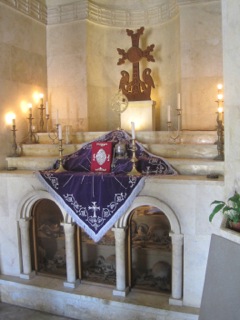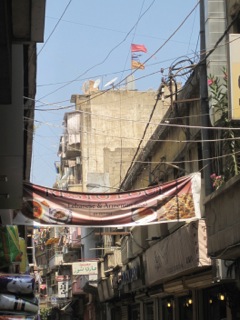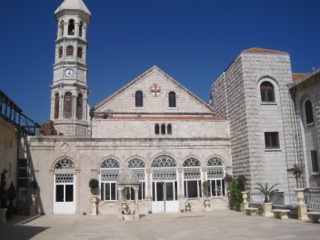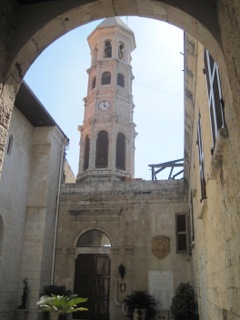The centrality of Lebanon to the global Diaspora is particularly true in the area of religious life. Although almost exclusively Christian, the Armenian community is in fact split into three denominations, with the majority Apostolic Church coexisting uneasily with much smaller congregations of Armenian Catholics and Evangelical Protestants. All three have established centers of global importance in Lebanon.
By Irina Papkova
The idea that Middle Eastern Christianity is threatened with extinction has been gaining ground of late, as the Christian communities of Iraq, Syria and most recently Egypt have shrunk visibly due to the ongoing violent turmoil in their respective countries. The issue has even garnered the attention of BBC and CNN, while politicians both in the US and elsewhere have attempted to seize on it as an example of the dangerous consequences of politicized Islam.
When I moved to the Middle East, I wanted to learn more about the region’s Christian communities, and to find out for myself if they are declining and, if so, why? As a resident of Beirut, Lebanon was the obvious place to begin my journey. The country is home to twelve different Christian denominations, reflecting the religion’s extreme fragmentation even in its historical heartland. The Armenian community, in particular, had caught my attention. I had visited Armenia and I wondered how the life of Lebanese Armenians differed from that of their compatriots.
The very presence of the Armenian community in Lebanon contains in it the story of unexpected resilience in the face of seemingly insurmountable odds. At the turn of the twentieth century, approximately one and a half million Armenians lived in the Ottoman Empire, of whom only a few thousand were located on the territory of today’s Lebanon. In 1915, however, the Turkish government embarked on a genocidal policy that claimed the lives of most of the original population of Ottoman Armenians, leaving perhaps 100,000 surviving refugees. The survivors streamed desperately towards safer borders; by the 1920s, a substantial majority settled in what was then the French Mandate for Lebanon and Syria.
The fact that the fleeing Armenians were Christian proved crucial to the entrenchment of the population in Lebanon. The French government in charge of the territory in the early 1920s governed with the support of the local Christian inhabitants, pitting them against a minority Muslim population that opposed French rule. In order to boost Christian numbers, the government granted all arriving Armenians Lebanese citizenship in 1924, giving them a stake in maintaining Lebanon as the only country in the region where Christians were not in a clear minority.
After Lebanon achieved independence in 1943, the constitution granted each religious group on the country’s territory the right to manage large portions of its members’ affairs according to its own rules. Buoyed by constitutional guarantees that the community’s interests would be protected by the state, Lebanon’s Armenians built churches and schools, founded benevolent associations, radio stations and medical facilities, and established political parties. The scope of the national revival was such that the Levant soon became the political and cultural center of the global Armenian Diaspora.
Several generations later, Armenians still constitute an important part of Lebanon’s social fabric. Armenian jewelry shops line the streets of Muslim West Beirut, also home to Haigazian University, the only Armenian institution of higher learning outside the Armenian Republic. The municipality of Bourj Hammoud, a ten-minute drive from Beirut proper, hums with Armenian businesses, its streets adorned with Armenian flags and graffiti excoriating Turkey. For decades, Bourj Hammoud has been home to the all-Diaspora offices of the three main Armenian political parties, and of international Armenian benevolent associations and print media.
The centrality of Lebanon to the global Diaspora is particularly true in the area of religious life. Although almost exclusively Christian, the Armenian community is in fact split into three denominations, with the majority Apostolic Church coexisting uneasily with much smaller congregations of Armenian Catholics and Evangelical Protestants. All three have established centers of global importance in Lebanon. For the Apostolics, spiritual life revolves around the Beirut suburb of Antelias; for the Catholics, the name of the mountain village of Bzoummar has similarly sublime resonance. The Evangelical hub is somewhat more diffuse, but the main institutions are concentrated in West Beirut. I spent some time exploring all three localities, in an effort to better understand their symbolic and practical importance for Armenian Christians, both in and outside Lebanon.
Since the eleventh century AD, the Armenian Apostolic Church has had two administrative centers, known as Catholicosates. Historically, the Catholicos of Etchmiadzin was located in the Caucasus, while the Catholicos of Cilicia resided in what is today Turkey. The Genocide wiped out the institutions of the church in Cilicia, forcing its Catholicos to flee to Lebanon. There, the American Committee for Relief in the Middle East (a charity working with Armenian refugees in the region) leased the Catholicos an orphanage in Antelias, allowing for the reestablishment of the Apostolic Church’s administrative structures and making Antelias one of the most important global spiritual centers for Armenians of the Apostolic faith. It remains so today, second only to Etchmiadzin.
The reverence with which the Apostolic Armenians I met tended to pronounce the word “Antelias” led me to imagine a place far removed from the hustle and bustle of Beirut, possibly on a hill but definitely surrounded by lush greenery. But as my taxi sped along the dusty coastal road barely two miles north of the capital, I soon spotted a fortress-style red wall jutting out from a sea of concrete apartment blocs and, behind it, the traditional cupola of an Armenian Apostolic church. A few minutes later, I stood in the heart of the Catolicosate’s power, a compound clearly built to impress. A giant courtyard laid out in black and pink stone opened up in front of me, girded on the left by a soaring pale pink cathedral framed by palm trees and on the right by the Catholicos’ residence, a two story building adorned with intricately designed columns. Facing me was a solid looking building of light-colored bricks housing administrative offices and a museum dedicated to the Armenians of Cilicia; behind me, a sort of cloister built into the wall that I had seen from the road.
But the most poignant structure of them all stood humbly to the left of the cathedral: a tiny chapel built in memory of the Genocide victims. The Antelias memorial is a somber sanctuary, a narrow space barely big enough for five people. As I walked in, the dark interior lit up automatically, a soft light accompanied by peaceful choral music pumped in through hidden speakers. My eyes were drawn to the marble altar, which is mounted over a glass case displaying neatly arranged skulls and bones. Built in 1938, the chapel has become an integral part of the annual Genocide commemorations that take place in Antelias each year on April 24th, the day traditionally understood by Armenians as the start of the Genocide in 1915.
Archbishop Nareg Alemezian, a gregarious and welcoming man with a full grey beard met me in his office in the Catholicosate’s administrative building. As we sipped coffee (an inevitable accompaniment to any formal visit in Lebanon), he launched into a detailed exposition of Antelias’ role in the life of Apostolic Armenians. He told me how the commemoration of the Genocide is an important yearly event, drawing thousands of pilgrims from across Lebanon and abroad for two days of prayer. But Antelias is more than just a location for outpouring the nation’s grief over its losses; it hosts other pilgrimages, including one to commemorate St. Gregory the Illuminator of Armenia, whose relics are housed in the complex along with many other relics brought from Turkey. The Catholicosate also has a seminary at Antelias, training priests for parishes of the Armenian Apostolic Church under its jurisdiction worldwide, excluding only the territory of the former Soviet Union. Antelias, in short, has functioned as the heartbeat of the Armenian Apostolic Church for the past 80 years—a place both of remembrance and of practical administration.
The Armenian Catholic monastery at Bzoummar is of much older provenance. Built in 1749, the convent stands at an elevation of some 3,000 feet, at the right hand side of a steep winding road leading from the Mediterranean coast up into the wilds of Mount Lebanon. Upon arrival, I stood for a few minutes admiring the uniquely Lebanese vista of green valleys and limestone cliffs visible for miles around Bzoummar, interrupted from my reverie by the appearance of my host, eighty-year old Father Antranig Granian. We spoke in French as he guided me through the monastery, pointing out elements of architectural significance and expounding on the history of the Armenian Catholic Church in Lebanon.
In sharp contrast to Antelias, where the architecture is self-consciously Armenian in style, Bzoummar struck me immediately as a typically Lebanese environment, with thick brick walls sporting red tile roofs and rounded arches. A few minutes into my conversation with Father Antranig I understood the source of this distinction. Unlike Apostolic Armenians, who arrived en masse in Lebanon only in the 1920s, the Catholic Armenians first came to Mount Lebanon in the late seventeenth century, fleeing persecution by Ottoman authorities. In the middle of the eighteenth century, the Pope permitted the establishment of an autonomous Catholic Armenian patriarchate, with its seat at the Bzoummar monastery. Since then, Bzoummar has been home to an administration that covers all Armenian Catholics dispersed around the world and, more than that, functions as an intellectual center with a seminary and a library of rare Armenian manuscripts.
After showing me the monastery’s main church and talking with me for a while on a low, brocaded sofa, Father Antranig passed me on to his assistant, Father Moses, a large and much younger man who led me through the Bzoummar grounds. “Voila, there is the monastery winery,” he said with visible pride, pointing to a vine-covered brick building. “And here—the museum.” The three rooms he showed me hold perhaps one twentieth of Bzoummar’s collection of ecclesiastical and secular antiquities, some of them Armenian but also Byzantine, Roman, and even Phoenecian, fragments of the culture that first settled Lebanon eight thousand years ago.
The sense of rootedness in Lebanese history permeates Bzoummar, bolstered by its role in the survival of the Armenians post-Genocide. Father Antranig’s eyes glittered with pride as he related that, when the Genocide survivors streamed towards Lebanon’s borders, the reigning Catholic patriarch was able to convince a reluctant French governor to grant them refuge. “He told the French, you know the fathers of Bzoummar as good and useful members of Lebanese society,” said Father Antranig. “’We are Armenian. The refugees are Armenian. Let them in.’ And the French did.”
A discrete number of the arriving refugees were members of the Armenian Evangelical church. Within a few years, they had joined the pattern established by the Apostolics and Catholics in transforming the Lebanese space they inhabited into an important spiritual location, if on a somewhat different scale. The structure of the global Armenian Evangelical communion is highly decentralized, meaning that there is no administrative “center” in the manner of Bzoummar or Antelias. Instead, there are several geographically based Armenian Evangelical Unions. Lebanon is important in this context in as far as the executive committee of the Union of the Near East is based in the country, while the Near East School of Theology, located in West Beirut, trains pastors for Evangelical churches in seven countries in the region.
Still, if one were to identify a single location as embodying the essence of the Protestant Armenian community in Lebanon, it would not be the Near East School of Theology, but rather Haigazian University, also in West Beirut. Sprawling over several blocks of tree-lined rue Mexique, Haigazian is the only Armenian institution of higher learning outside Armenia itself. Visiting one day in late spring, earlier this year, I had to pick my way through crowds of students, most of them identifiably Armenian and speaking English, which also happens to be the language of instruction.
“The university welcomes students from all backgrounds, including non-Armenians,” the university’s president Reverend Paul Haidostian told me as we chatted in his book-lined office in the university’s ornately decorated administration building. But the president is always Evangelical Armenian, and always a theologian with impeccable scholarly credentials. This is because Haigazian owes its establishment in 1955 to the global Evangelical Armenian community, and depends for its existence on Evangelical donors, largely outside Lebanon. Paradoxically, then, while Antelias and Bzoummar can be thought of as centers of Armenian Christian activity with missions directed out towards the Diaspora, Protestant Armenians from the global Diaspora pool their resources to support Christian mission inside the country, in an attempt to shore up the declining Armenian community.
For the reality is, outside the pleasantly bustling confines of Antelias, Bzoummar and Haigazian, the Armenian community in Lebanon is on the decline. At its height, prior to the Lebanese Civil War of 1975-1990, the Armenian population numbered around 250,000. But the war and the political and economic instability that has plagued Lebanon since the end of hostilities have taken their toll. Reliable statistics are difficult to come by, but the best estimates place the current population of Lebanese Armenians at somewhere between sixty and one hundred thousand, suggesting that the community has shrunk by at least half over the past forty years.
The fate of parishes and schools tells a similar story. In 1973, the Apostolic Armenian Church ran a network of twenty-three elementary and secondary schools; at present, there are 11. Prior to 1975, the Evangelicals could boast of twelve parishes in Lebanon, each with its own school. That number has decreased to five. Across the board, Apostolic and Catholic priests and Evangelical pastors alike complain about low and declining church attendance, particularly among young people.
The apparent decline can be attributed in part to the assimilation of Armenians into the predominantly Arab Lebanese culture. Archbishop Nareg told me, during my visit to Antelias, that the last decade has seen the active integration of Armenians into wider Lebanese society, as rates of both mixed marriages and of Armenian youth for whom Arabic is the language of choice have increased dramatically. For Archbishop Nareg, this process is sad but inevitable, as more and more Armenian families choose to send their children to non-Armenian schools in order to provide them with better employment opportunities in the long-run if they are to have any future in Lebanon.
This observation points to a profound irony at the heart of complaints about the decline of the Lebanese Armenian community. During much of the twentieth century, the internal energies of Armenian religious leaders, teachers, politicians and activists of all stripes were focused on preserving and strengthening an Armenian nation that would some day be capable of returning to territories lost during the Genocide. Like the Palestinians currently residing in camps in Southern Lebanon, the Armenians dreamed of going home. Some still do. In the course of my wanderings through the world of Lebanese Armenians, I encountered a politician who informed me that “we are close, very close to an agreement – the Turkish government WILL return the lands to us. Soon. Very soon.” He told me that, in anticipation of this restoration of justice, the role of Armenian schools and churches in Lebanon is to reinforce the Armenian identity of young people, to ensure that they “continue the struggle.” But the evidence suggests that the young generation is no longer interested; they are perhaps more concerned with economic survival in the midst of global financial instability.
In short, lamentations about the decline of the Lebanese Armenians are not so much about the loss of a Christian community in Lebanon per se, but about the waning likelihood that future generations will use Lebanon as a launching pad to reclaim a lost homeland. The increasing assimilation of Armenians might actually be interpreted as a positive development, as proof that the population has been able to take full advantage of economic and social opportunities offered by the Lebanese state; the decline of the Armenian Christian population means only the slow loss of ethnic specificity but not the death of a religious community—assimilated Lebanese Armenians merely become Christian Lebanese without the ethnic marker. Whether this is a good or bad thing depends on one’s point of view.
Yet, despite the evident decline in numbers, the Armenians of Lebanon are by no means a dying community. Archbishop Nareg shared his impression with me that emigration of Armenians has slowed since 2008, for the simple reason that previously attractive destinations such as the United States or France are no longer seen as attractive alternatives to escaping Lebanon’s economic malaise. Both the archbishop and Reverend Haidostian pointed out to me that there has actually been a fairly significant influx of Armenians into Lebanon from neighboring Syria since the start of that country’s brutal civil war.
The assimilation process may also not be as inevitable as it seems. After all, the political security the Armenians enjoy in Lebanon is predicated precisely on their identification as Armenian—being a member of the community means having guaranteed representation in Parliament, as well as a quota of government jobs, among other privileges. The continued existence of Armenian schools and especially of Haigazian University still partially counteracts the trend.
Finally, the fact that Lebanon is the site of spiritual centers of great importance for all three Armenian denominations scattered through the Diaspora suggests that the Armenian Christians here will survive in one form or another for a long time to come. As long as Apostolic, Catholic and Evangelical Armenians view the country as a hub of pilgrimage and theological education that benefits the Diaspora as a whole the community, even if reduced in size from its glory days, will remain vital.
Irina Papkova is a Research Fellow at Georgetown University’s Berkeley Center For Religion, Peace and World Affairs. She received her Ph.D. from Georgetown University and has previously taught at Georgetown and George Washington Universities. Her book, “The Orthodox Church and Russian Politics,” was published by Oxford University Press and Woodrow Wilson Center Press in 2011.Irina’s current research includes religion and politics in the Middle East, with a particular focus on Lebanon. She is a regular contributor to The Revealer.
With support from the Henry R. Luce Initiative on Religion and International Affairs.






